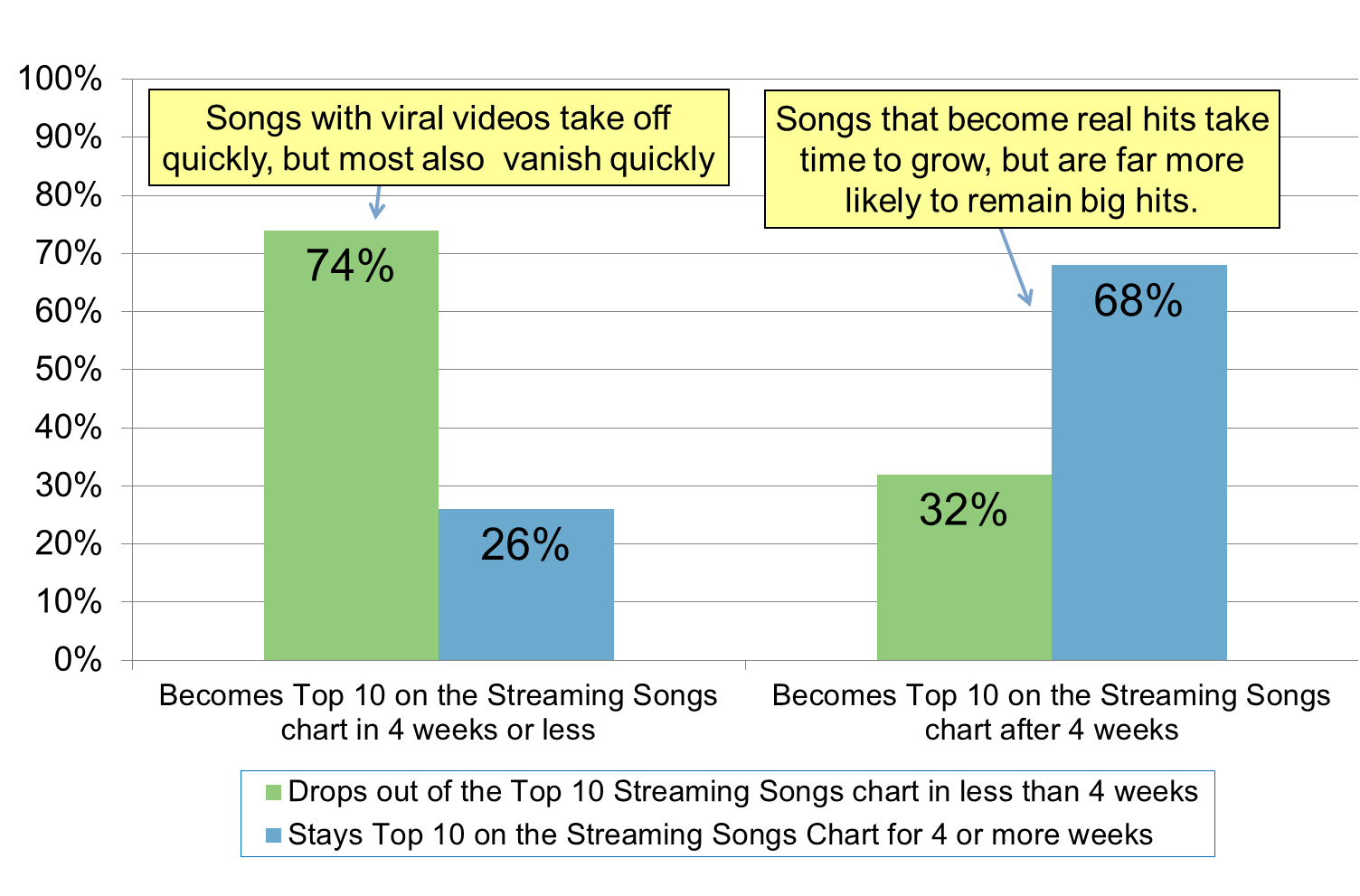This is the fourth in a series about how listeners engage with music across traditional and emerging platforms
YouTube has emerged as a key medium for music consumption and discovery, especially among teens and young adults. Carly Rae Jepsen’s “Call Me Maybe” broke on YouTube. Psy’s “Gangnam Style” became a cultural touch point on YouTube. Other songs’ videos, such as Baauer’s “Harlem Shake” and Rebecca Black’s “Friday” also racked up record-setting views, but weren’t what we would traditionally consider hit songs.
As part of our ongoing analysis of when is a hit a hit, we examined 26 weeks of Top 10 songs on the Billboard Streaming Songs chart, which includes songs played on both on-demand services (which we examined previously) and semi-interactive internet radio services, but most notably also tracks video views on services including Vevo and YouTube.
First, the same general hit song life cycle that we observed for radio and for on-demand services also holds true for the broader streaming category including YouTube: Songs are typically growing in their first eight weeks, the majority of the biggest Top 10 songs are between nine and 20 weeks old and songs are typically in decline after 20 weeks. Secondly, the vast majority of the biggest hits on radio and on-demand are the exact same songs that are the biggest hits when we also include YouTube views.
However, we did uncover a handful of songs that emerge as Top 10 most streamed songs much earlier than songs typically do specifically because of their success on video services such as YouTube. Does a high volume of YouTube views shortly after a song’s release predict the song will be a hit?
The vast majority of the songs that become overnight YouTube sensations are obviously irrelevant to your radio station: Weird Al Yankovic’s “Word Crimes” became a most-streamed song overnight, but we know you weren’t expecting it to be a real hit in the long run no matter how many times you saw it on Facebook. As with most novelties that go viral, it was over after barely a week. However, many programmers added the Chainsmokers’ “’#SELFIE” when it quickly became a top viewed video, but interest in #SELFIE vanished almost as fast as a selfie on Snapchat.
While “#SELFIE” might be an obvious novelty in hindsight, not all examples of this phenomenon are so obvious. Nicki Minaj “Anaconda” also topped the Streaming Songs chart early on thanks to its video views. In fact, it broke the 24-hour streaming record on Vevo with 19.6 million views on day one. Given the artist, programmers had every reason to believe it could be a big hit. While it did receive plenty of radio airplay, “Anaconda” didn’t remain a hit for nearly as long as big hits usually do. Ultimately, the song’s appeal was driven more by the novelty of sampling Sir Mix-a-Lot—coupled with copious footage of Ms. Minaj’s posterior in the video—than by the musical merits of the song itself.
How can you tell the difference between a hit of the year and a viral video of the week?
- Songs that people mainly watch for the video typically become Top 10 streaming hits in their first four weeks, but tend to disappear almost as quickly as they emerge. Seventy-four percent (74%) of songs that become Top 10 on the Streaming Songs chart within their first four weeks stay Top 10 for less than four weeks
- Songs that become Top 10 hits beyond YouTube typically take longer than four weeks to establish themselves as Top 10 hits, but are much more likely to remain hits for weeks to come. Of songs that took more than four weeks to become Top 10 on the Streaming Songs chart, 68% of those songs stay Top 10 songs for four or more weeks
Songs with videos that catch on quickly usually also vanish quickly (Copyright © 2014 Billboard Magazine)
Iggy Azalea’s “Fancy”, MAGIC!’s “Rude”, Sam Smith’s “Stay With Me”, Nico & Vinz’ “Am I Wrong” and Calvin Harris “Summer” all took at more than four weeks to work their way to become Top 10 most streamed songs. However, they then stayed in the Top 10 for many more weeks.
Bottom line: When a song becomes an overnight YouTube sensation, ask yourself: Is this song popular because it’s a great song in its own right, or are those YouTube views driven by the video and/or by novelty? In most cases, it will be blatantly obvious. On that rare occasion when you can’t tell if a new song is the next “Call Me Maybe” or if it is another “#SELFIE,” examine if it’s becoming a YouTube sensation after being out for less than a month. If it is, odds are the song will vanish almost as quickly as it emerged.
Our final installment in our series will examine Shazam. Is Shazam the hit-detecting oracle radio programmers have always hoped to discover?


Why wouldn’t you include how many $$$ downloads a song has to factor in if it’s hit or not?
Brian, we examined single digital download sales in our second and third installments of this series. You can find them here (https://colemaninsights.com/coleman/news/when-is-a-hit-a-hit) and here (https://colemaninsights.com/coleman/news/why-strong-sales-debuts-can-lead-to-stiffs). Thank you for reading!
Pingback: 13 Content Marketing Hacks That Will Help You Attract More Clients
Pingback: IdOMUSIC®